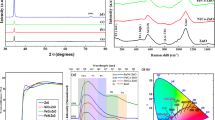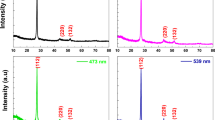Abstract
The ZnO and gallium-doped ZnO nanoparticles (NPs) were synthesized by simple chemical method and used for the fabrication of p-polyaniline/n-ZnO heterostructures devices in which polyaniline was deposited by plasma-enhanced polymerization. The increment in the crystallite sizes of gallium doped ZnO nanoparticles from ~21.85 nm to ~32.39 nm indicated the incorporation of gallium ion into the ZnO nanoparticles. The surface and structural studies investigated the participation of protonated N atom for the bond formation between polyaniline and gallium-ZnO through partial hydrogen bonding. Compared to a Pt/polyaniline/ZnO diode, the fabricated Pt/polyaniline/gallium-ZnO heterostructure diode exhibited good rectifying behavior with Current–Voltage characteristics of improved saturation current, low ideality factor, and a high barrier height might due to the efficient charge conduction via gallium ion at the junction of the polyaniline/gallium doped-ZnO interface.

(a) Schematic illustration and (b) I-V characteristics of Pt/PANI/Ga-ZnO heterostructure device. The heterostructure device is obtained by a top Pt layer on PECVD deposited PANI/Ga-ZnO electrodes. The fabricated Pt/PANI/Ga-ZnO heterostructure device displays non-linear and rectifying behavior of I–V curve due to the existence of Schottky barrier via a Schottky contact at the interfaces of Pt layer and PANI/Ga-ZnO thin film layer.




Similar content being viewed by others
References
Jun JH, Cho K, Yun J, Suh KS, Kim TY, Kim S (2008) Enhancement of electrical characteristics of electrospun polyaniline nanofibers by embedding the nanofibers with Ga-doped ZnO nanoparticles. Org Electron 9:445–451
Mbhele ZH, Sakmane MG, Van Sittert CGCE, Nedeljkovic JM, Djokovic V, Luyt AS (2003) Fabrication and Characterization of Silver—Polyvinyl Alcohol Nanocomposites. Chem Mater 15:5019–5024
Zhang H, Du N, Chen B, Li D, Yang D (2009) Carbon Nanotube-ZnO Nanosphere Heterostructures: Low-Temperature Chemical Reaction Synthesis, Photoluminescence, and Their Application for Room Temperature NH3 Gas Sensor. Sci Adv Mater 1:13–17
Li X, Gao Y, Zhang X, Gong J, Sun Y, Zheng X, Qu L (2008) Polyaniline/CuCl nanocomposites prepared by UV rays irradiation. Mater Lett 62:2237–2240
Bhatt SV, Vivekchand SRC (2006) Optical spectroscopic studies of composites of conducting PANI with CdSe and ZnO nanocrystals. Chem Phys Lett 433:154–158
Kalita G, Adhikari S, Aryal HR, Wakita K, Umeno M (2010) Poly(3-octylthiophene)/Fullerene Heterojunction Solar Cell Incorporating Carbon Nanotubes. J Nanosci Nanotechnol 10:3844–3848
Vispute RD, Talyansky V, Choopun S, Sharma RP, Venkatesan T, He M, Tang X, Halpern JB, Spencer MG, Li YX, Riba LGS, Iliadis AA, Jones KA (1998) Heteroepitaxy of ZnO on GaN and its implications for fabrication of hybrid optoelectronic devices. Appl Phys Lett 73:348–350
Wu W, Bai S, Cui N, Ma F, Wei Z, Qin Y, Xie E (2010) Increasing UV Photon Response of ZnO Sensor with Nanowires Array. Sci Adv Mater 2:402–406
Soitah TN, Chunhui Y, Liang S (2010) Effect of Fe Doping on Structural and Electrical Properties of Nanocrystalline ZnO Thin Films Prepared by Sol-Gel Dip Coating Technique. Sci Adv Mater 2:534–538
Irimpan L, Nampoori VPN, Radhakrishnan P (2010) Optical Limiting in ZnO Nanocomposites. Sci Adv Mater 2:578–582
Khan A, Khan SN, Jadwisienczak WM (2010) One Step Growth of ZnO Nano-Tetrapods by Simple Thermal Evaporation Process: Structural and Optical Properties. Sci Adv Mater 2:572–577
Zeng H, Cui J, Cao B, Gibson U, Bando Y, Golberg D (2010) Electrochemical Deposition of ZnO Nanowire Arrays: Organization, Doping, and Properties. Sci Adv Mater 2:336–358
Ding R, Liu J, Jiang J, Ji X, Li X, Wu F, Huang X (2010) A General Solution Synthesis Route to ZnO-Based Nanorod Arrays on Ceramic/Silicon/Quartz Glass/Metal Substrates. Sci Adv Mater 2:396–401
Shen G, Chen D (2009) 1-D Hetero-Nanostructures: From Growth to Devices. Sci Adv Mater 1:213–226
Kaneto K, Takashima W (2001) Fabrication and characteristics of Schottky diodes based on regioregular poly (3-hexylthiophene)/Al junction. Curr Appl Phys 1:355–361
Al-Heniti SH (2010) Growth and Properties of Aligned ZnO Nanowires and Their Applications to n-ZnO/p-Si Heterojunction Diodes. J Nanosci Nanotechnol 10:6606–6611
Kim M-H, Suh M, Gowrishankar V, McGehee MD, Kwon Y-U (2010) Confinement Effects of P3HT in Nanochannels and Their Implications for Bulk Heterojunction Solar Cells. J Nanosci Nanotechnol 10:279–284
Mridha S, Basak D (2008) ZnO/polyaniline based inorganic/organic hybrid structure: Electrical and photoconductivity properties. Appl Phys Lett 92:142111–142113
Ameen S, Ansari SG, Song M, Kim YS, Shin HS (2009) Fabrication of polyaniline/ heterojunction structure using plasma enhanced polymerization technique. Superlatt Microstruct 46:745–751
Umar A, Al-Hajry A, Hahn YB, Kim DH (2009) Rapid synthesis and dye-sensitized solar cell applications of hexagonal-shaped ZnO nanorods. Electrochim Acta 54:5358–5362
Monkman AP, Stevens GC, Bloor D (1991) X-ray photoelectron spectroscopic investigations of the chain structure and doping mechanisms in polyaniline. J Phys D Appl Phys 24:738
Barr TL (1991) Recent advances in x-ray photoelectron spectroscopy studies of oxides. J Vac Sci Technol A93:1793
Sans JA, Segura A, Royo JFS, Barber V, Fenollosa MAH, Marí B (2006) Correlation between optical and transport properties of Ga-doped ZnO thin films prepared by pulsed laser deposition. Superlatt Microstruct 39:282–290
Chen Y, Kang ET, Neon KG, Lim SL, Ma ZH, Tan KL (2001) Intrinsic redox states of polyaniline studied by high-resolution X-ray photoelectron spectroscopy. Colloid Polym Sci 279:73–76
Kang ET, Neoh KG, Tan KL (1998) Polyaniline: A polymer with many interesting intrinsic redox states.Prog. Polym Sci 23:277–324
Kumar SN, Gaillard F, Bouyssoux G, Sartre A (1990) High-resolution XPS studies of electrochemically synthesized conducting polyaniline films. Synth Met 36:111–127
Ameen S, Akhtar MS, Ansari SG, Yang OB, Shin HS (2009) Electrophoretically deposited polyaniline/ZnO nanoparticles for p–n heterostructure diodes. Superlatt Microstruct 46:872–880
Rhoderick EH (1988) Metal Semiconductor Contacts. Oxford University Press, pp. 121
Sze SM (1981) Physics of Semiconductor Devices, Vol 849. Wiley, New York
Elmansouri A, Hadik N, Outzourhit A, Lachkar A, Abouelaoualim A, Achour ME, Oueriagli A, Ameziane EL (2009) Schottky Diodes and Thin Films Based on Copolymer: Poly(aniline-co-toluidine). Active Passive Electron Comp 2009:1–5
Saxena IV, Santhanam KSV (2003) Junction properties of Schottky diode with chemically prepared copolymer having hexylthiophene and cyclohexylthiophene units. Curr Appl Phys 3:227–233
Fabre B, Lopinski GP, Wayner DDM (2003) Photoelectrochemical Generation of Electronically Conducting Polymer-Based Hybrid Junctions on Modified Si (111) Surfaces. J Phys Chem B 107:14326–14335
Ohdomari J, Tu KN (1980) Parallel silicide contacts. J Appl Phys 51:3735
Im HJ, Ding Y, Pelz JP, Choyke WJ (2001) Nanometer-scale test of the Tung model of Schottky-barrier height inhomogeneity. Phys Rev B 64:075310
Acknowledgments
The Human Resource Development Center for Economic-Region-leading Industry” Project supported by the Ministry of Education, Science, & Technology (MEST) is fully acknowledged. We would like to thank Mr. Kang Jong-Gyun, Center for University-Wide Research Facilities, Chonbuk National University for his co-operation in TEM images. We also acknowledge the Korea Basic Science Institute, Jeonju branch, for utilizing their FESEM facility.
Author information
Authors and Affiliations
Corresponding author
Additional information
Sadia Ameen, Young Soon Kim and Hyung-Shik Shin contributed equally to this work.
Rights and permissions
About this article
Cite this article
Ameen, S., Akhtar, M.S., Kim, Y.S. et al. Polyaniline/gallium doped ZnO heterostructure device via plasma enhanced polymerization technique: Preparation, characterization and electrical properties. Microchim Acta 172, 471–478 (2011). https://doi.org/10.1007/s00604-010-0507-x
Received:
Accepted:
Published:
Issue Date:
DOI: https://doi.org/10.1007/s00604-010-0507-x




